The world of shipping is a magical thing. The world is full of ships, aircraft, trucks, and trains working in concert to deliver the goods, regardless of whether they’re a simple letter or a ginormous power transformer. If you have a ridiculously heavy and large piece of equipment and you’re shipping it by rail, there’s a chance that it might end up on something called a Schnabel car. But this isn’t any normal railcar. The art of the Schnabel car is that it actually turns your cargo into a whole train car, where the cargo itself becomes a load-bearing structure complete with two dozen axles.
There are just under a few dozen Schnabel cars in the United States. Due to their rarity and their special use case, many railfans may never see a Schnabel car in action in years, if not decades, of chasing trains down the rails. For many railfans, catching a Schnabel on the rails in real life is like finding the holy grail.
Despite their rarity, Schanabel cars exist for a critical reason. According to the United States Energy Information Administration, this country is home to 12,538 power plants generating at least 1 megawatt of power. The American power grid is supported by over 500,000 miles of high-voltage transmission lines and another 5 million miles of distribution lines. That alone is mind-boggling, but there’s one more vital component to keeping the lights on and it’s the large-power transformer (LPT). These specially-constructed units, which can cost over $7 million a piece and weigh around 440 tons (970,030 pounds) or more, are used to step up or step down power along the line. If an LPT fails, it can cause an electrical service interruption and costly damage.
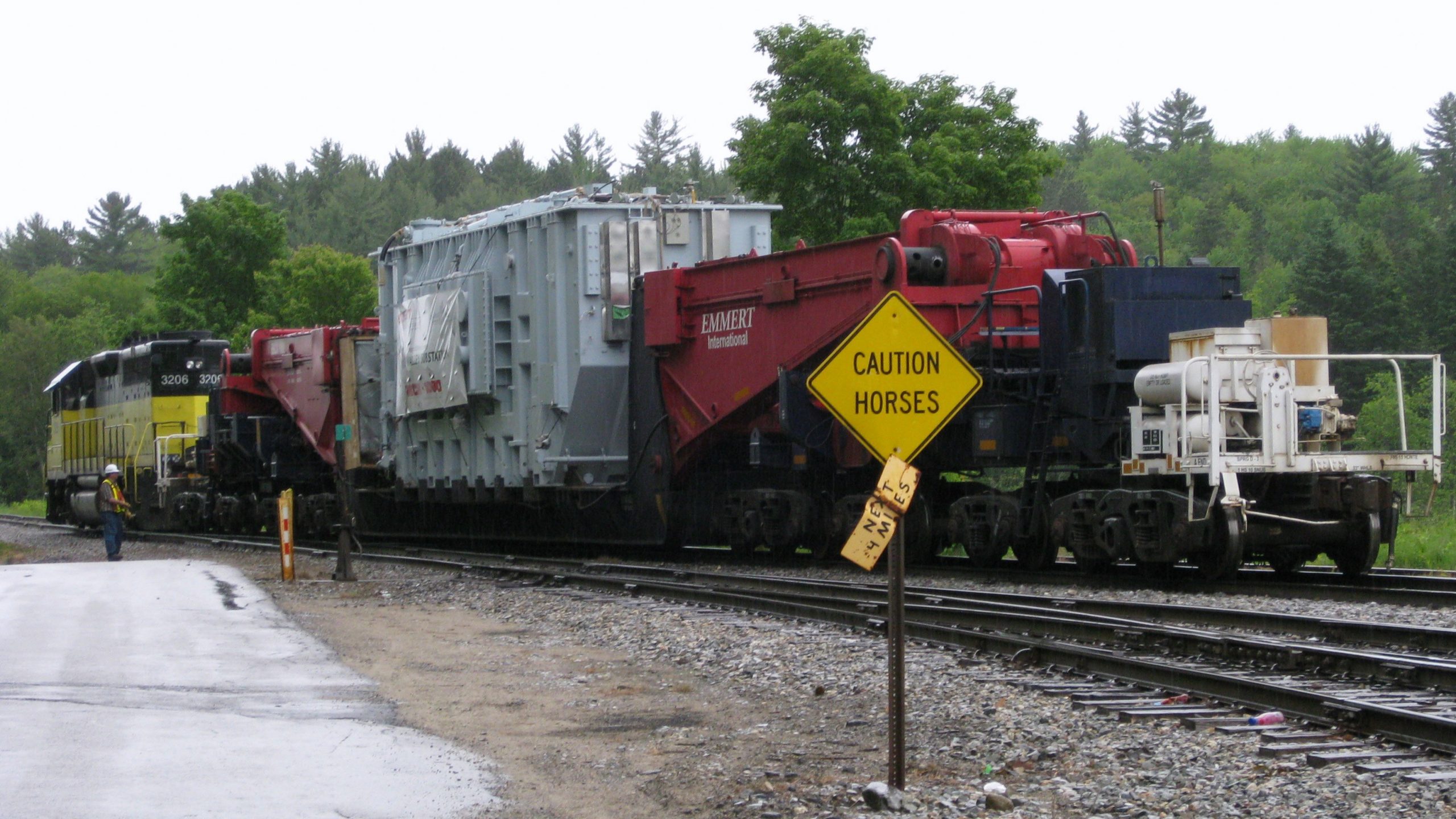
As Forbes reported in 2014, LPTs are made to order and are heavily customized, so there isn’t a supply of them just sitting in a warehouse waiting to be shipped. But when an LPT does need to make its way to an American locality, there’s really only one way to deliver it, and it’s by rail.
However, this presents a problem. As the United Pacific Railroad notes, standard flatcars are up to 89 feet long and can carry up to 202,000 pounds. For extra-heavy loads, there are also specialty flatcars and depressed-deck cars designed to carry up to 740,000 pounds of cargo. TTX Company, a railcar pooling provider, says these extra heavy-duty cars will often be used to support power generation, including: “Boilers, turbines (including wind energy hubs and nacelles), electrical transformers, pressure vessels, and shipments that frequently require special handling and train operations.”

But what if you have something that’s even heavier? Or what if you have something that’s so huge that it can’t fit on even a heavy-duty railcar? For those mammoth loads, you need an equally colossal, dedicated rail platform. That’s the Schnabel car, pictured above, and without it, American energy would be very different.
Nearly A Century Of Heavy Hauling
Finding history on the Schnabel car has been rather difficult, but reporting from Trains.com has helped. The Schnabel car appears to have been invented in the early 1930s in Germany. The word “Schnabel” comes from the German term “tragschnabelwagen,” which roughly translates to carrying-beak-wagon. Vintage tragschnabelwagens looked like two bird beaks connecting a large piece of equipment together and suspending it over a track.
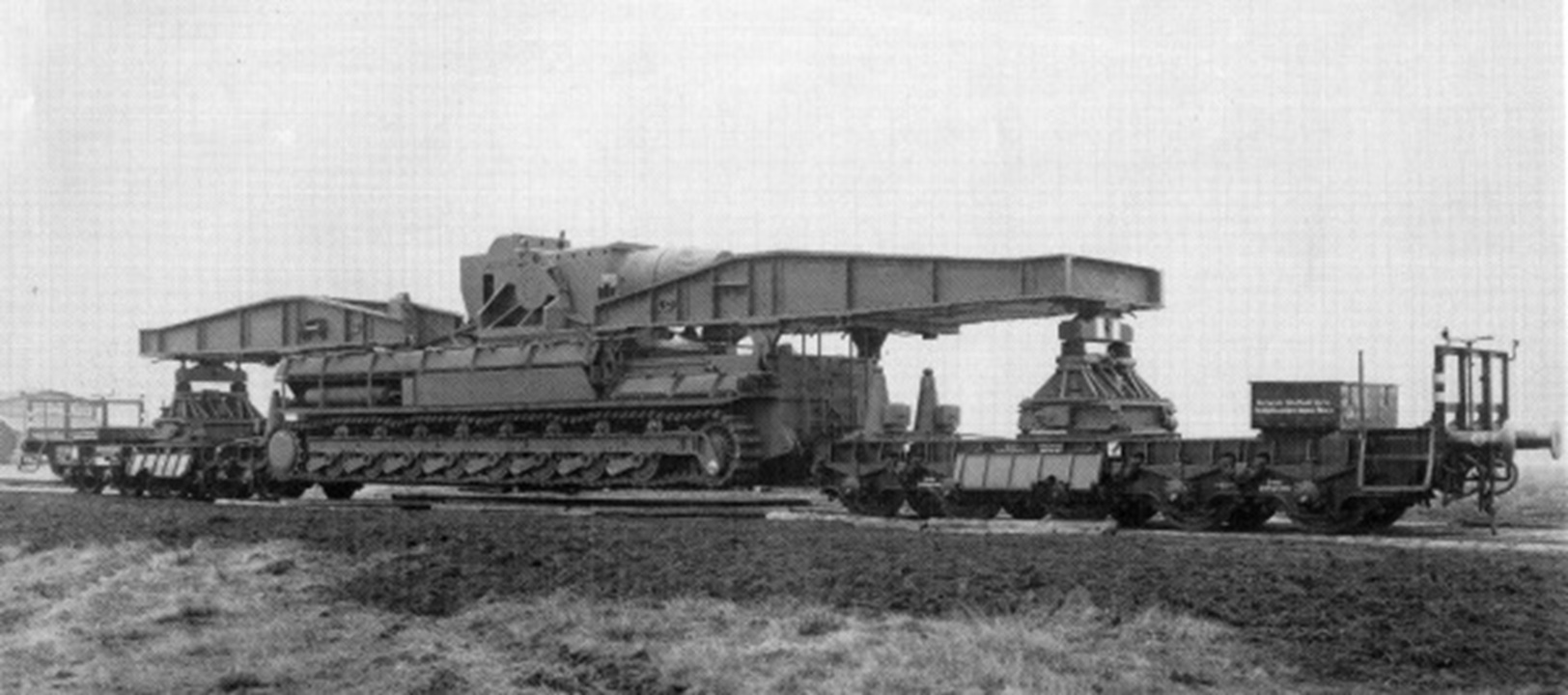
The earliest image I could find of a tragschnabelwagen is the one above, which depicts a Schnabel wagon carrying a Karl-Gerät self-propelled mortar in 1945 during World War II. French forces also used Schnabel cars to carry their own heavy gear.
The earliest mention that I’ve found of a Schnabel car here in America is in 1958 from Westinghouse. That year, the company said that the Schnabel car was an important breakthrough as it allowed the company’s power transformers to grow large enough to handle 450,000 kVA. Back then, Westinghouse transformers weighed 250 tons and no other railcars were able to carry the gigantic beasts. That car was known as WECX 200, and it was built by Greenville Steel Car Company of Greenville, Pennsylvania in 1957. Railfans consider it to be the first Schnabel car in America.
How It Works
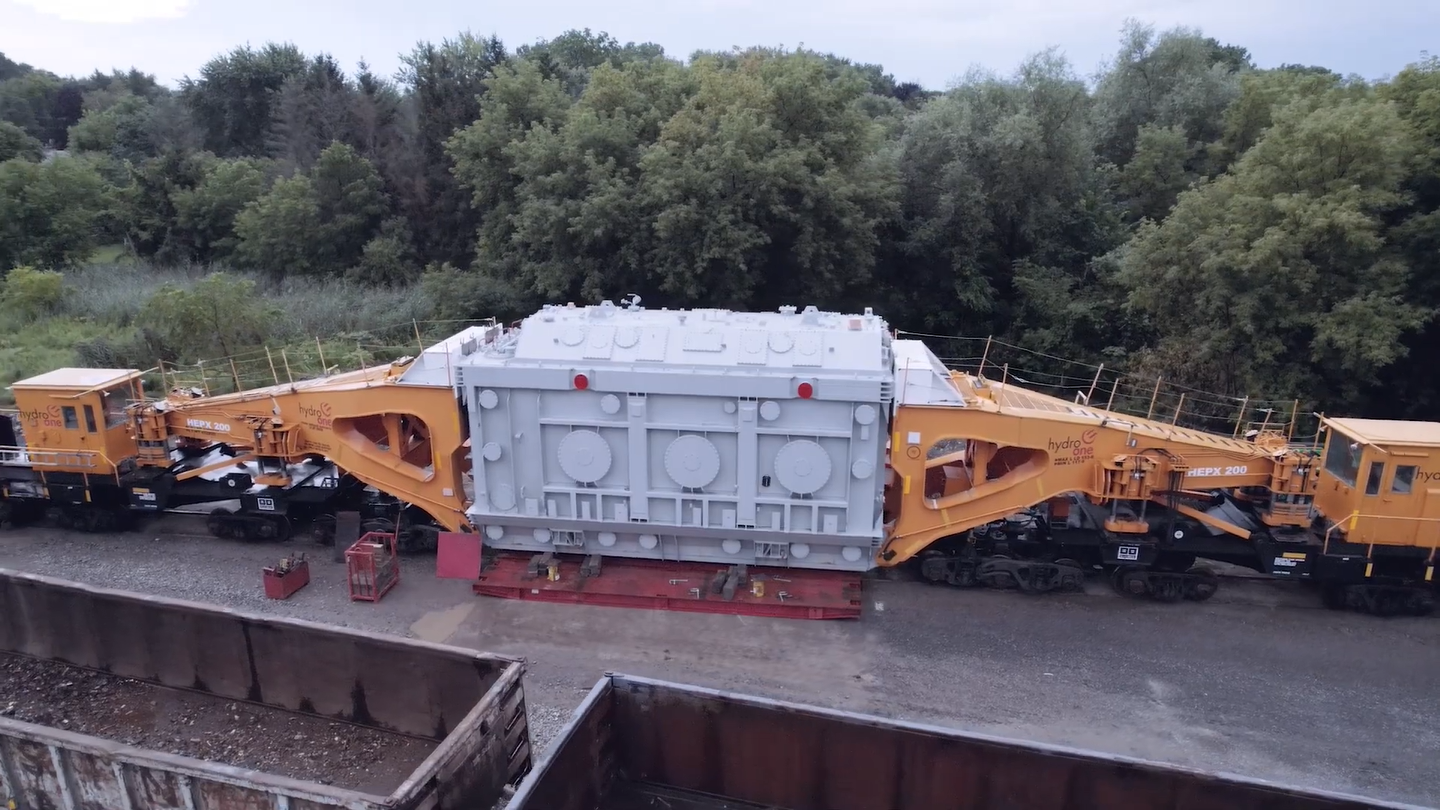
The concept of the Schnabel car back then was similar to how it is today. The railcar is actually two separate railcars with several axles. Attached to these railcars are two massive lifting arms. When these cars are empty, the two arms are bolted together, forming one giant railcar.
When it comes time to carry a load, the equipment is bolted to the lifting arms, and then the arms lift the equipment off the ground. Once the equipment is lashed up, the two Schnabel car ends and the equipment become one rigid railcar. In practice, it means that the piece of equipment being hauled is bearing a heavy structural load as if it were a railcar.
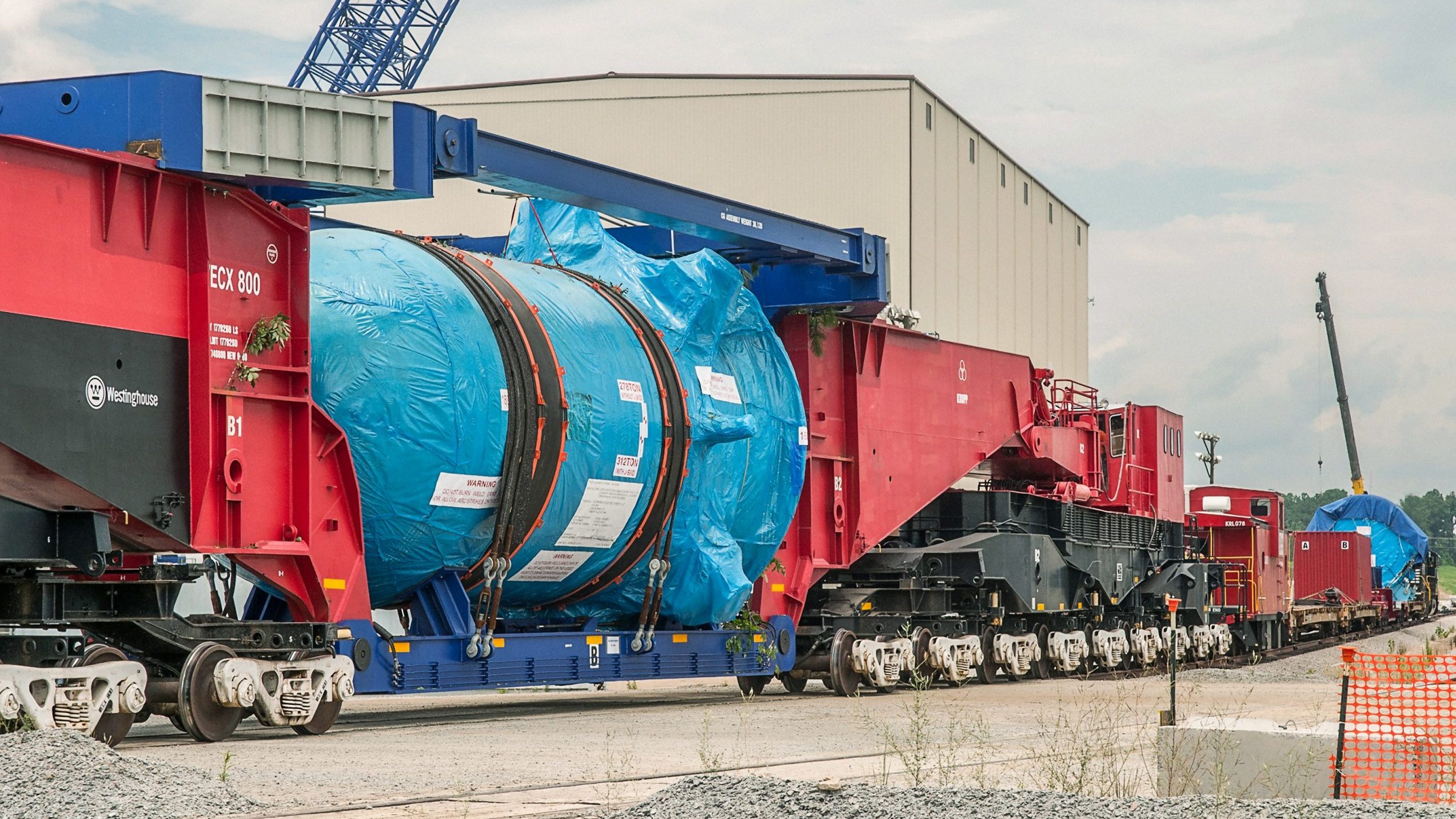
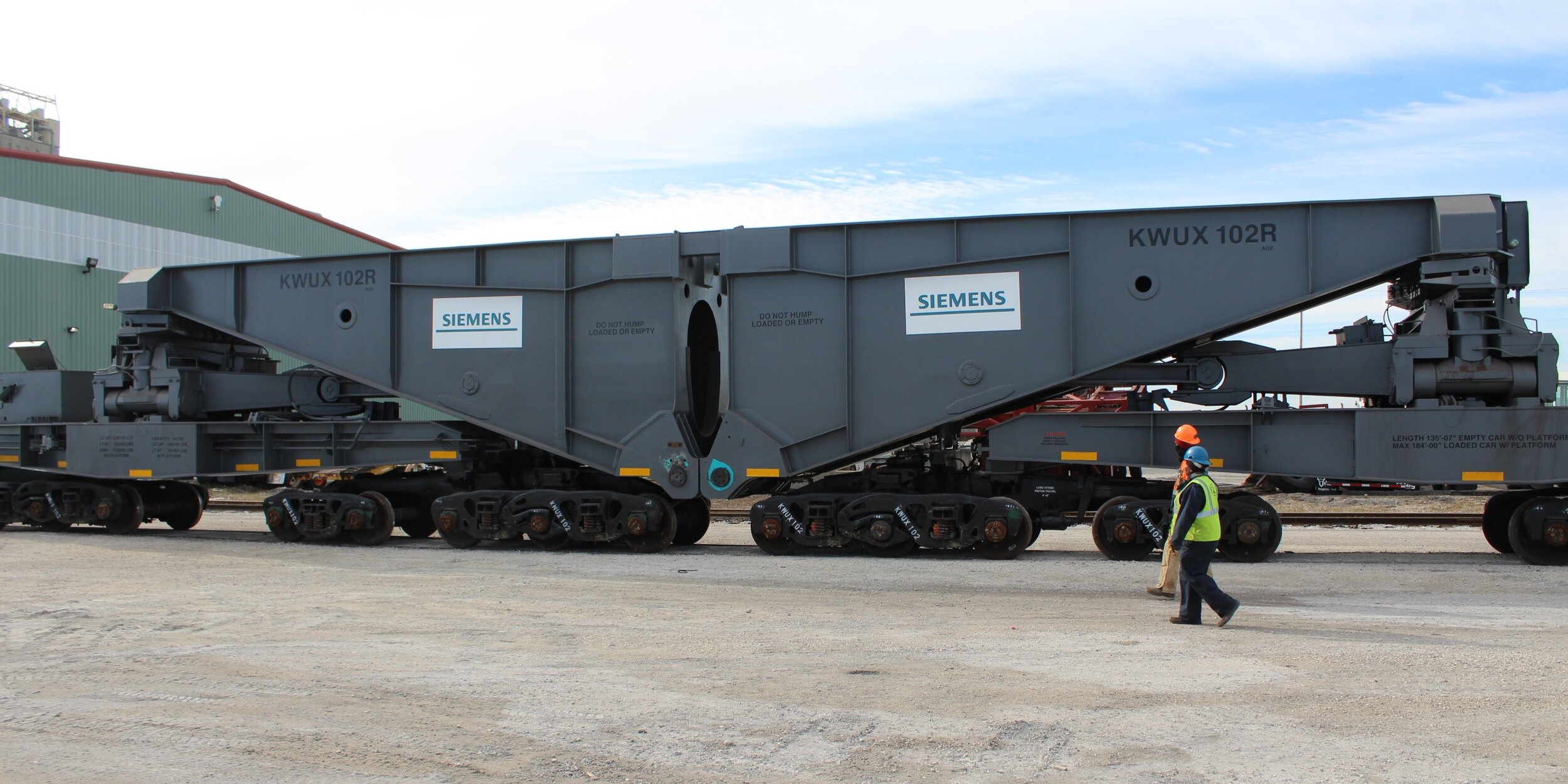
If, for whatever reason, the load cannot bear the weight of being a train car, there is an easy fix. An operator may insert a bridge into the lifting arms, pictured above, creating what’s essentially a super extra large depressed-deck car. However, there’s way more to a Schnabel car than that.
Since Schnabel cars carry hilariously huge and heavy loads, they’re highly specialized freight vehicles. The railcar can’t have what’s more or less a million pounds of weight centered on small patches on the rails, so Schnabel cars spread out the weight of the load across dozens of axles. The largest Schnabel car in the world, the WECX 801, built by Kasgro Railcar in Pennsylvania in 2012, has a total of 36 axles and weighs 880,967 pounds (399.6 tons) all on its own. That’s wild when you remember that these cars can then carry a single piece of equipment weighing in at a million pounds on its own. WECX 801 is so huge that it’s one of the largest railcars in the world.
One special feature of some Schnabel cars is that the arms actually sit on pivots and can use hydraulic rams. These allow the arms to move the load to the outside of a turn or help the train crew move the load to clear crossing gates, trees, signals, switches, or other obstacles that may be in the way. This is a bigger deal than you might think. A loaded Schnabel car may be as long as 300 feet or so, and that makes turns quite dramatic. If a load on a Schnabel car takes a turn on a line with two tracks, the overhang may be so huge that the load actually crosses over the entire second track during the turn.
WECX 801 is capable of shifting its load 40 inches laterally and 44 inches vertically. These movements happen shockingly slow, so slow that you might not even notice them happening.
Special Operations
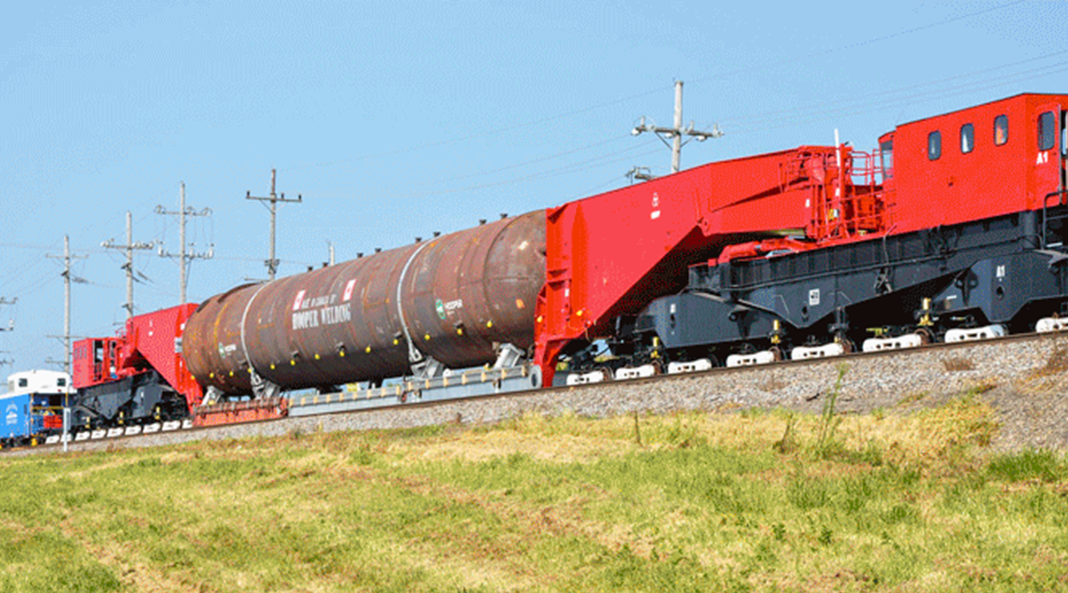
If this sounds like a delicate and crazy operation, you’re not wrong. These cars also carry reactor containment vessels, generators, oil refinery towers, and anything else that’s way too huge and way too heavy to go onto a regular railcar.
BNSF Railway says that shipping something on a Schnabel car calls for a special operation. Schnabel cars are given their own special train consists.
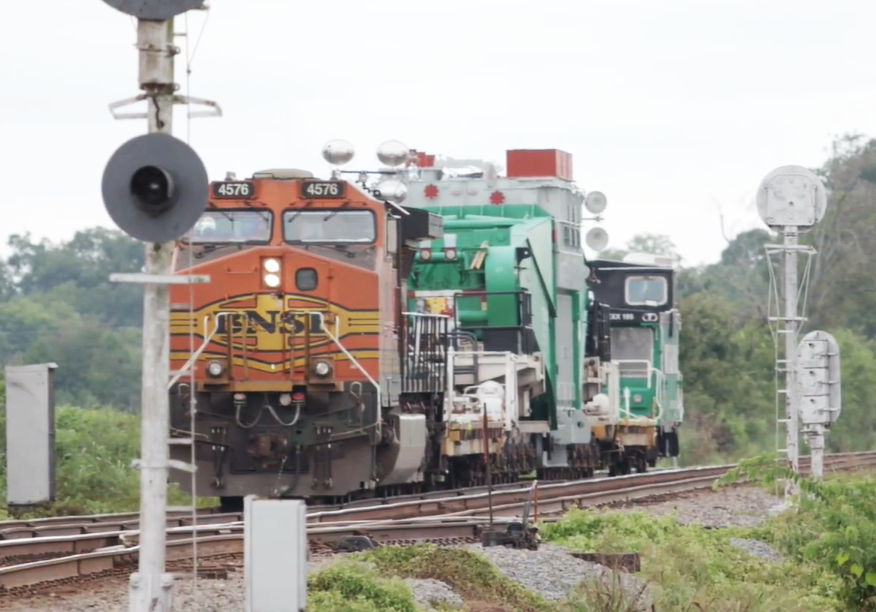
These trains will have the pulling locomotive, the Schnabel car, and support and tool cars. They also commonly have a caboose for the train crews that need to monitor and run the train and the Schnabel car. That crew may also have mechanics and welders who can fix the train in the field if something goes wrong.
But that’s it. You won’t find a Schnabel car as a part of a regular freight train.
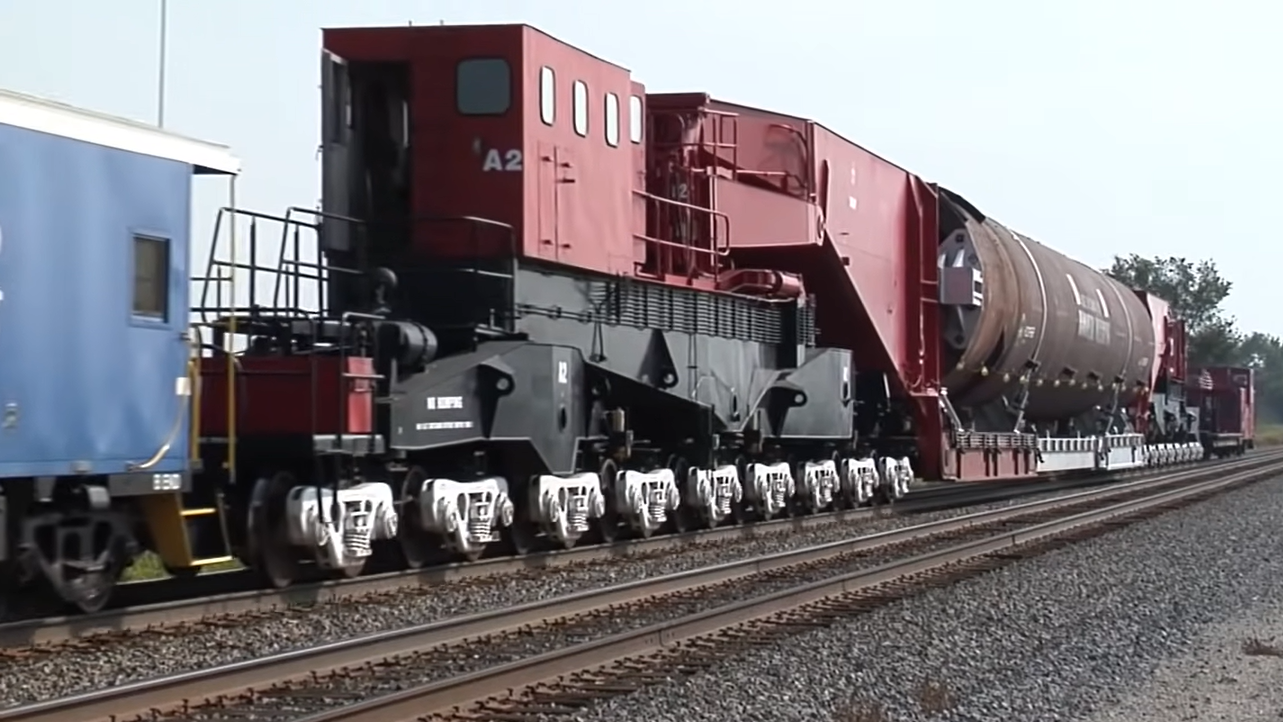
BNSF notes that the Schnabel cars it runs for clients permit a maximum height of 19’9″ and a maximum width of 13’1″. This substantial size means that the railroad has to plan anywhere from months to a year before a move can happen with a Schnabel car. During that time, the railroad will ensure that the load can actually fit under bridges, around curves, and through grade crossings without causing havoc. Routing is also cleared through the Railway Industrial Clearance Association.
When it’s finally go time for the move, the train will also go slowly. Some Schnabel car movements go as slow as 10 mph, while faster moves are still a leisurely 25 mph. Due to this slow speed, it can take a railroad a week or longer to deliver a load through a Schnabel train.

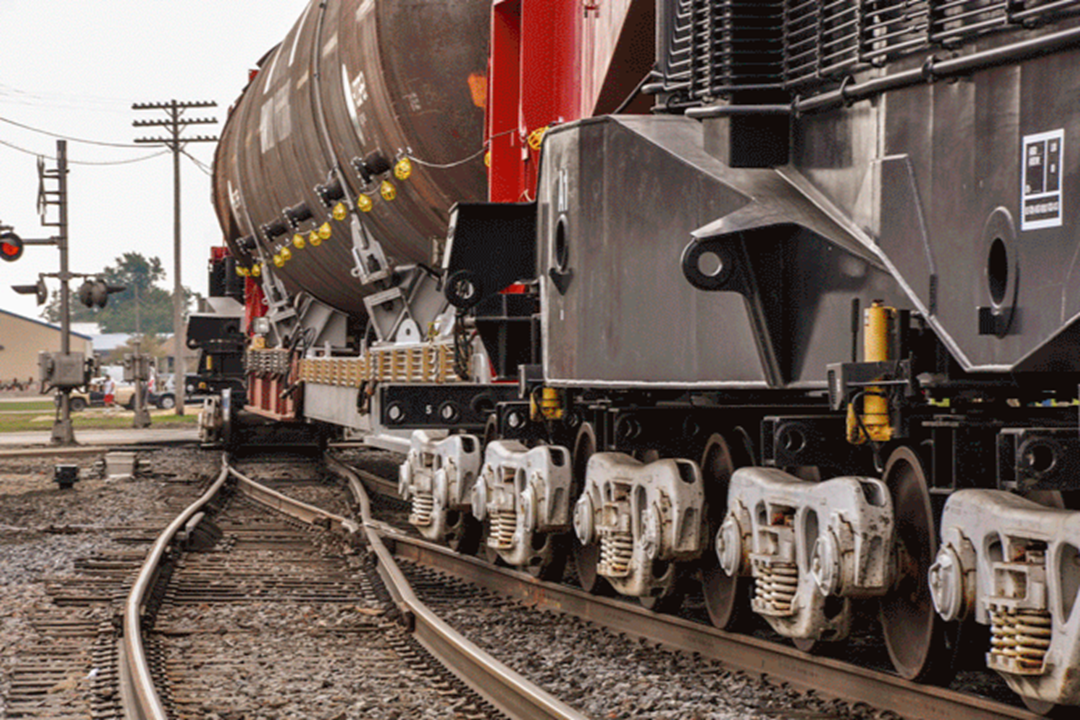
Other kinds of Schnabel cars include a one-piece lifting arm design that more or less “hugs” the load above the ground. There’s another one-piece design that has the appearance of a depressed-deck car that was scaled up in Photoshop. But these two other types are less common.
Chances are that most reading this piece may never see a Schnabel car. There are fewer than 100 Schnabel cars in the entire world right now, and their owners, typically private companies contracting railroads to haul the loads, use them only when needed. Keep in mind that a gigantic transformer moving at just 25 mph is going to slow down a railroad’s operation. Many other companies also get by just fine by hauling their loads on specialized semi-tractors or in much faster aircraft when such is possible.
Still, Schnabel cars fall into a sort of niche, but a very important one. They are just one major cog in the wheel of American power generation and heavy logistics. But, even if you ignore that, these railcars are also just seriously cool. If you’re a railfan or even just tangentially interested in trains, keep your eyes peeled. Maybe one day a Schnabel will roll slowly through your town.








Why do they need a big dumb train car? Just put it in the bed of a Ford Ranger.
I love infrastructure. Trains, telecom, power grid, bridges, all of it. This stuff is how modern society functions, and it’s fascinating to me.
I think I saw one of these sitting at the port in Duluth, MN 20 years ago. I was on a boat tour of the Duluth/Superior harbor and there was a really weird-looking train car sitting at one of the docks. The boat captain said it was for hauling really heavy mining equipment up to the Iron Range.
Wow, Mecedes! Yet another fascinating deep dive and well written article about something I hadn’t given much or any thought about before.
Driving from Colorado Springs to Denver International Airport (DEN) on I-25, six years ago, I saw a train carrying blades for very large wind turbines. It was mesmerizing and I kick myself to this day for not turning around and getting into position to photograph it. Somebody probably has, and probably with better equipment than the iPhone I had with me. It probably would’ve been pretty cool to have shot with a drone as well.
I’ve read that the railroad security/police are pretty prickly about drones flying over the tracks. But in rural areas, the chances of being hassled are pretty low.
Sometimes you do drop a billion dollar nuclear reactor though
https://www.augustachronicle.com/story/business/2013/01/10/vogtle-reactor-vessel-slips-between-savannah-burke-county/14469012007/
Whoops! The article was short on details and cause. But Mercedes’ original article got me thinking about moving big, heavy stuff to the end point and it can be quite a choreography.
Okay that Chris Boden video had me laughing
So what happens to the million pound item when the Schnabel reaches its destination “station”? I’m assuming the train tracks don’t pull right up to where the item has to go because, they’re like, train tracks, you know?
What do you use to unload and move the item into position?
Check out Squirrelmaster’s comment below!
Thanks! Figured it was something like that; or like when I visited the Kennedy Space center back in the 80’s and got to see one of the transports for the space shuttle. That has to be a slow moving logistical nightmare navigating the item from the tracks to the destination.
To Aaronaut’s comment: That’s one thing about this site that drives me a little crazy… the order that comments show up. In my mind, when you get to the end of the article, it should be you see the oldest comments first and have context for the newer ones below.
Webmaster: are you listening?
Agreed. Never understood why it goes to the last page of comments first.
One of these came through Mid-Michigan about three weeks ago moving a transformer between a couple of power plants across the state. I was able to get a couple of pictures in the middle of the night.
CSX Train Location Updates – April 2025 – Page 24 – RailRoadFan.com
Way back when I was helping to bid to build a really large windmill for the time. If anyone here is both old enough and was in the San Francisco bay area you might remember or have seen it. In 1980, PG&E purchased one of the first operational Boeing MOD-2 machines. This behemoth windmill used a metal propeller that extended 300 feet from end to end (one football field) and weighed nearly 100 tons. It was erected east of I-680 between Benicia and Cordelia. We (Boeing Aerospace Company) were asked by Boeing Marine Systems to bid on making a bigger one! One failed attempt to stress relieve a thirty foot section of the thick steel blade during testing resulted in the section potato chipping overnight! Yikes. Scrap. The main spar was steel with portholes inside to allow access for welding it all together. The ends were supposed to rotate and the design called for wood! The transition from steel to wood was still being designed. The welding of the steel main spar (2 bladed by the way) was so big that in order to inspect the welds with X-ray, we would have to shut down the entire site every night to bring in the equipment and X-ray in the open so all non-xray techs would have to be evacuated. Then, in order to stress relieve one, the only facility large enough to do that was in Los Angeles at a oil company heat treat facility that they use for oil derricks. We would have to barge them down and back to Seattle. If it wasn’t apparent, it was ridiculous. We deliberately overbid the contract as there was no way we wanted to actually try to build it.
I drove (and rode a motorcycle) past that windmill/generator many times. 2.5 megawatts! Pretty impressive.
It rotated at a much lower rpm than the units on many other wind farms that I have passed since then. But I stopped nearby once on a particularly windy day, and it sounded like the blade tips were getting close to transonic. I was saddened when it was taken down in 1988. I have no idea why it was.
And not to be pedantic, but I seem to recall it was on the west side of 680.
The main problem was that they chose the wrong bearing type which allowed the cyclic loads when the blade passed the tower to create high loads on the bearings which then failed early. I think the use roller or ball bearings when they should have used a sleeve bearing. I wasn’t directly involved in the project, so memory is hazy.
Wasn’t that windmill painted red, white and blue? I remember passing it on a regular basis when I was a kid. And yes, it was on the west side of 680.
I don’t recall it being particularly colorful. What few photos of it I found online showed it as being all white. And the articles I read back up Knowonelse’s recollection of why it failed and was taken down.
Sometimes they’re used fro size, not weight. Here’s a truck version with a windmill tower:
https://www.youtube.com/watch?v=vgxFzWcu4UE
I got to see one of these when they were bringing in the oil combustion chambers from Japan for the heavy oil upgrader in Regina Sask. I got the heads up to see the thing from my brother who was working on the engineering team at the refinery when it was being built. He ended up working for the company that owned the Schnabel car used.
https://www.flickr.com/photos/12343930@N00/albums/72157648297180624/
Cool! The PR release in the article mentioned a crawling crane with a capacity of over a megaton. Now I want to learn about that.
And refineries are pretty fascinating. Chevron-Phillips added on or built one a couple of miles east of Baytown, TX while I lived there. At one point, there were a dozen cranes on site. And the “plumbing” was pretty amazing. Driving by as it was being built gave me a new appreciation for the term “pipefitters.”
Also, who designed this? And how did they do this before CAD?
You will have to zoom in a bit.
https://maps.app.goo.gl/6LssgVibpDvuC7qR6
Cad existed back then. Autocad and other very high end systems were available. I studied EE and we used sun workstations with circuit and chip design software. The cell lists were sent to a university in eastern canada for verification and to be processed into silicon at northern telecom, bell northern research.
At uni we did FEM work on cyber mainframes through tektronics workstations.
I do recall loads of cranes in use. The refinery was in the far north of Regina and we lived in the south end. I didn’t get there often.
I saw a coal train being unloaded once. Two cars at a time were decoupled and drawn into a gigantic machine that clamped them and rotated them almost 180 degrees to empty out the coal. Start to finish it took about two minutes. About a half million pounds of coal dumped in a matter of seconds, over and over until the whole train was emptied. Big machines like that are pretty impressive.
That’s the good kind of “rolling coal”
Yeah, big machines are fascinating
When I moved to Cleveland, OH in 1992, these things were still in operation.
https://youtu.be/JErREoMOdDc
Go to about 6:20 into the clip. When all were in use, they were mesmerizing, like a windmill farm.
Reminded me of the ether-filled “drinking birds.”
If the power plant is not setup for bottom discharge from the hoppers the coal cars will have a rotating coupler on one end. Then a whole train through the dumper without uncoupling cars. A remote-controlled switcher locomotive will be used to move the train one car length at a time. That is why coal cars often have a stripe or similar marking at one end.
I worked at a chemical plant where they used one of these to bring a two million pound reactor tower into the facility. It was pretty interesting to watch how they dismounted the reactor. They later loaded it onto a mobile platform to slowly carry the reactor to its new home. The platform was more interesting than the rail car because not only did it have like eighty wheels, but each wheel was hydraulically-powered and could rotate independently of the others and each wheel’s suspension could articulate up and down to keep the platform level. Pretty neat stuff to watch.
Saw one of those wheeled transporters being used in Ottawa when they were replacing highway bridge decks. Cool machines!
One of my favorite examples of one of those platforms had a modular design, so not only could it be built to match any size cargo, it could also be (slowly and painstakingly) iteratively disassembled and reassembled while in use to clear obstructions.
I didn’t see this in any of the pictures used. All the pics I saw showed the equipment secured to a load bearing frame of some sort.
Take a look at the Hydro One transformer in the photo just below “how it works”. It looks like the transformer is being loaded or off-loaded onto a red skid. There does not appear to be any means for that skid to support the transformer under load.
FWIW, I inspected a boiler at an idled facility in Arizona. The boiler was practically new and was properly laid up, but required transport via Schnabel to a port where it could then be barged up the coast. The Schnabel typically puts enough stress on the boiler to warrant rerolling all tube penetrations into the drums, and restoration of all refractory. Even though the boiler was being sold for its scrap metal price, the transport cost and remedial action to make it serviceable following transport made this uneconomical. The rail travel was the biggest part of this cost.
thanks-I see it now. As I go back through the pics, I can see the Schnabel “pinching” some of the loads.
I just saw this on Physicsduck’s channel.
Some might enjoy his stuff as he works at a 100yo hydro power facility “built to last a century!”
-fair bit of hilarious profanity
“Caution Horses” is a bit of an understatement. That GP40 should have right at about 3,000 of them.
Shouldn’t that lede be saved for ‘The Morning Dump’?
No, no, no. What you DON’T do is tell them how to publish.
Now tell us what you DO do.
You’re right. Discharge what I said earlier. Your number 2 point is correct.
As with any major invention or discovery, I always feel like it has to start out as “We built this awesome new power generator!”
“How are we gonna move it?”
“Damn it all to hell.”
On a small scale, this is just Ken Imhoff building a Lambo in his basement without realizing it can’t fit up the stairs. On a large scale…well.
Protip is to use as much water transport as possible. Odds are good the Dutch have something waterborne that can handle whatever you’ve got.
I feel blessed by this totally irrelivent info I was just sucked into as I wait for the last hour of the work day to creep by.
keep up the great work, Mercedes
In most of the US, you wouldn’t use a train to carry that load for far. Mississippi River barges can carry up to 1500 (short) tons or 3 million lbs of stuff.
There’s a place in Finland that makes Diesel engines that weight 2300 metric tons. Or over 5 million lbs. They are right on the water and they have a special truck and trailer that takes it to the cranes to load it aboard a ship to be delivered. The engine is used for container ships and is a fun thing to look up. Hopefully this image link will work.
https://inteng-storage.s3.amazonaws.com/images/import/2016/02/731.imgcache-1024×634.jpg
I was on a nearly 1100 foot long container shop once. Didn’t get to see the engine but I walked through the control room and the engine was turning at 102 rpm’s.
This is very similar to how we transport large concrete bridge beams for roadways. They are moved by semi truck, but they’re not put on a trailer. They attach a 5th-wheel assembly to the front of the beam, and an 8-wheel “truck” to the rear. They then run air lines for brakes and electrical cables for lights down the beam. The beam itself IS the trailer.
I’ve gotten to see steel beams being transported on the interstate using a setup like this. Seeing a load that large being transported by truck is fascinating on its own, but the pilot car drivers are something else, neatly swooping in when needed to keep oblivious drivers away.
Didn’t expect to see my nemesis pictured on the Autopian. This is Emmert International’s specialty but as a side hustle they bought a bunch of distressed properties in my town and continue to do nothing with them bet let them fall further into disrepair. Something about a tax write-off of the capital gains because it’s in an opportunity zone from the tax cuts in 2017.
Cool engineering, but F that guy.
I drive by a number of his lots including the one full of random used houses on the way to town, they have for-sale/lease signs posted now. Emmert is a sprawling empire and I think the old man can’t keep track of it all anymore. That’s the way of empires I guess, and I doubt there’s anyone capable of understanding the whole thing.
All the commercial properties he has around here stay empty because they try to charge Seattle rent rates in the ass end of nowhere. Doesn’t even take care of the buildings or renovate them to try and justify it. One of them still has an ongoing massive roof leak!
Holy p=mv, batman!
The BIG logistics hurdle is getting this from the railyard/port to one’s place of business for installation. We had 6 200′ long vessels transported from port to one of our sites a few years ago and the logistics are mind boggling. I missed the transit but field supervised the install.
200 feet long? The biggest hurdle I faced was going 12 feet in diameter. They had to find a route that didn’t take down power lines or go under bridges. I could drive to the plant in less than an hour and it took 8 hours for them to deliver that vessel.
And time it so they hit town in the wee hours, I’ll bet. We had a similar path/issue with a transformer of our own for the substation we built in the city center a few years ago.
We were close at 10′ OD